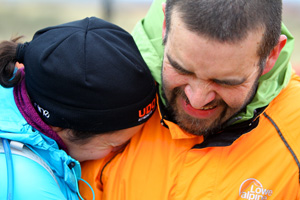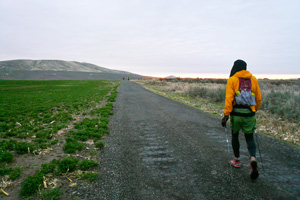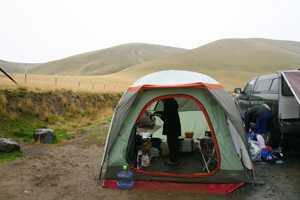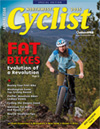Running: Crewing for a 100-Mile Ultramarathon

Test for the Sole/Soul
By Yitka Winn
Photo at right: George Orozco and pacer Jennifer Hughes embrace at the finish line. Photo by Glenn Tachiyama.
For most runners, running a marathon represents the pinnacle of this sport’s achievement— an item for the bucket list. For a handful, however, the marathon is only a gateway drug to a more hardcore test of human endurance: the ultramarathon.
My friend George recently caught the “hundo fever”— which is to say, he registered for a 100-mile ultramarathon. To help keep him moving for the 24-plus hours it would likely take to cover the distance, George asked me and several other running buddies to “crew” for him.

4: 23 hours into the Badger Mountain 100-miler, ultramarathoner Jason Vaughan treks toward the sunrise in southeastern Washington. Photo by Yitka Winn.
His challenge of choice, the Badger Mountain 100-Miler in southeastern Washington, rises and falls a staggering 20,000-plus feet. There are aid stations at regular intervals along the course, staffed with volunteers who stay up all night brewing hot soup, flipping pancakes and quesadillas on camp stoves, and tracking runners who come through. However, having his own crew would boost George’s chances of being among the roughly 50 percent of runners who typically make it to the finish line.
We called our crew Team Honey Badger. Although our primary responsibility was to George, the spirit of ultramarathons is one of camaraderie. Our van became a movable aid station for not only George, but also several of our other ambitious, nutty runner friends attempting the feat last March 30 –31.
The race began at 7 a.m. on Friday morning in typical Northwest fashion: cold, pouring rain. The 62 starting runners were in good spirits, though giddy on adrenaline and caffeine. We watched them trot away into the sagebrush-strewn, desert hills outside of Kennewick, then piled into our van to get out of the rain and find breakfast.
A crew’s job is multi-faceted. We leapfrogged George as he ran, meeting him every 10 – 20 miles to take care of whatever needs he had. We mixed up squeeze bottles of calorie-packed goop for him. In the afternoon, we visited a laundromat to dry runners’ sopping clothes. Other crews were sent on evening missions to get hot pizza for their runners.
Every time our runners come through, we asked, “What can we put in your bottles? What do you need?” We did not ask, “How are you feeling?” because we knew the answer: tired and hurting, and their bodies wanted to stop.
But they didn’t. The challenge of the 100-mile race is to dig deep within for the strength to keep moving forward.
The rain let up eventually, but 50 mph winds atop the course’s ridges continued to beat at the runners. Even in these conditions, they stayed positive. A sense of humor was a necessity.
“Do you need to change into a dry shirt?” Jennifer, a crew member, asked one of the runners. He stared blankly at her for a moment, before grunting a no. “Are you sure?” she asked. “I’m giving you my Disapproving Mother face.” He pondered this for a moment and replied, “Do you want me to give you my Petulant Teenager face?”
When night fell on Friday, the temperature dropped sharply. Perched atop dark mountainsides, the aid station tents were quiet refuges from the elements—and the running—that were beginning to take their toll on the runners.
Above us, the stars emerged. Below us, distant city lights shone. We stared into the darkness, watching for the tiny, bobbing headlamps of approaching runners. When they arrived, they slumped into camp chairs to slowly eat and meditate on the miles ahead.
Around midnight, our crew caught a few hours’ sleep in our van. When we woke up groggy and chilled, Jennifer and I pulled on running clothes. Like designated drivers for our increasingly loopy runners, we ran alongside as pacers to ensure they stayed awake and on course.
Jennifer jumped in with George, and around 4 a.m., I joined another runner, Jason. We took off into the hills, where we spent the next eight hours together, battling fatigue and steep climbs and the emptiness of a race that had dwindled to a handful of determined athletes.

Filled with hot chocolate, broth, and cheerful volunteers, aid stations are a runner’s oasis. Photo by Yitka Winn.
When the sun came up, it was Saturday and the racers had been running for 24 straight hours. At the aid stations, we heard stories of others’ struggles: one who’d dropped out due to hypothermia; another whose feet got so swollen his shoes had to be cut away with scissors. Another, running without the benefit of a pacer, got lost several miles off course in the middle of the night. When his wife tracked him down, he refused to get in her van, insisting on finishing the race on foot.
When George finally emerged from the desert hills on Saturday morning, Jennifer at his side, his part shuffle, part trot revealed both exhaustion and determination. His final time was 28:04. Brought home by a chorus of cheers from friends and strangers alike, he crossed the finish line with an elated smile.
While marathons earn finishers medals, the prize for 100-mile finishers is a more humble piece of metal—a belt buckle. After basking in the pleasure of initial post-100-miler inertia, George collected his buckle and headed back to the hotel for a shower, a milkshake, and a well-deserved 14-hour nap.
Yitka Winn of Seattle plans to run her first 50-miler this summer. Follow her adventures at www.yitkawinn.com.




